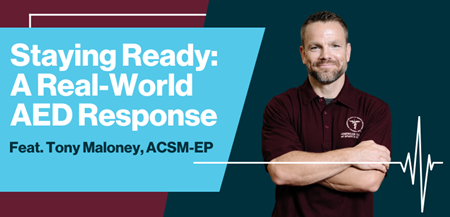Joe Sherlock, ACSM Copywriter |
Jan.
3, 2023

You never know when you’ll need to use your emergency training. That’s what ACSM member and Noblesville, Indiana, Orangetheory Fitness Head Coach Tony Maloney was reminded of in late October when a patron visiting from out of state collapsed suddenly in a mid-morning strength class.
Maloney had just finished the five-minute warm-up and started the initial working block. He was walking another client through a movement when he heard the visitor, an active man over the age of 60, fall to the floor. The coach immediately moved to render assistance, first establishing that though the man wasn’t unconscious per se, he was seemingly unable to speak.
“My first thought was sugar,” Maloney said. But he also cleared the area in case the man was having a seizure. Then the client became unresponsive.
Maloney and a patron with a medical background both checked for a pulse — neither could find one. That’s when Maloney retrieved the automated external defibrillator (AED) that was on the wall a mere five feet away. After he’d set it up and run a diagnostic, the machine advised a shock. Maloney moved everyone away and administered one. Then he began chest compressions.
“It was strange,” Maloney said. “You really only see it in the movies, but he came to after about 90 seconds of delivering compressions.”
It was just then that EMS first responders arrived.
While Maloney was attending to the client, Orangetheory staff and patrons had been working concurrently to make sure emergency services were inbound. When EMS loaded the man into an ambulance, he was, by Maloney’s estimation, “halfway coherent.” Though for privacy reasons, the coach wasn’t able to get a full picture of the outcome, he later learned that the man had been released.
Maloney first earned an ACSM certification back in 2009. Since then, he has worked with the college in various capacities to advocate for certification, including photo and video shoots. He’s also the ACSM-EP committee chair.
He was subsequently recognized for his lifesaving efforts by both the fire department and the city, receiving the Noblesville Fire Department Civilian Certificate of Recognition from the fire chief and the City of Noblesville Partner in Progress from the mayor.
Still, Maloney remains humble: “It was a team effort.”
And critically, the studio had done its due diligence: All Orangetheory patrons, even those dropping in from other locations, fill out a form that includes a brief medical history before they’re allowed to participate in a workout. The EMS responders informed Maloney that this information was particularly helpful, allowing them to tailor their response and be better prepared to react to the situation they were arriving at.
“We had all the info they needed to know right in hand when they walked through the door,” Maloney said. “I give a lot of props to the team and my studio manager, Tori.”
Further, Maloney himself had reviewed the client’s intake documents — the man had had a prior heart attack but had been cleared for exercise by a physician — and had been keeping an eye on him. So though the fall was sudden, Maloney wasn’t taken completely by surprise.
The Orangetheory team also runs regular drills to prepare for just such an emergency, always working to speed up their response time and making sure to thoroughly document their efforts. They also stress the importance of ensuring the AED is online and ready.
“Come in, turn on the lights and check the AED,” Maloney said.
Still, he’s taken the time to assess and learn from this particular incident. He noted two improvements came to mind: One, he should have remained with the client and assigned someone else to bring him the AED rather than retrieving it himself. Fortunately, it was only a few feet away. Two, he would have preferred that he’d designated one person to make the 911 call. As it happened, three or four patrons as well as the front desk phoned them.
In this line of work, you never know what you might encounter during a class. Fortunately, there are ways to prepare. Run your emergency drills. Keep an AED on hand. Review your clients’ medical histories.